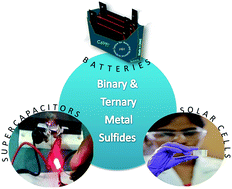Nanostructured binary and ternary metal sulfides: synthesis methods and their application in energy conversion and storage devices
Abstract
Metal sulfides, known as being analogous to metal oxides, have emerged as a new class of materials for energy conversion and/or storage applications due to their low cost and high electrochemical activity. They have shown fascinating properties such as excellent redox reversibility, conductivity, and capacitance. Further, binary metal sulfides have gained enormous attention due to their large redox reaction sites and high electrical conductivity compared to metal sulfides. Recently, use of binary metal sulfides as electrode materials for various applications such as lithium-ion batteries (LIBs), supercapacitors (SC), and solar cells has been extensively studied by various research groups and this review critically overviews the strategies and advances made towards attaining high performances from these sulfides in an effort to provide leads for scale-up and to find long term solutions for energy and environment crisis. Finally, challenges in achieving superior performances and the future scope of research for metal sulfide based energy materials have been outlined.

- This article is part of the themed collection: Recent Review Articles


 Please wait while we load your content...
Please wait while we load your content...